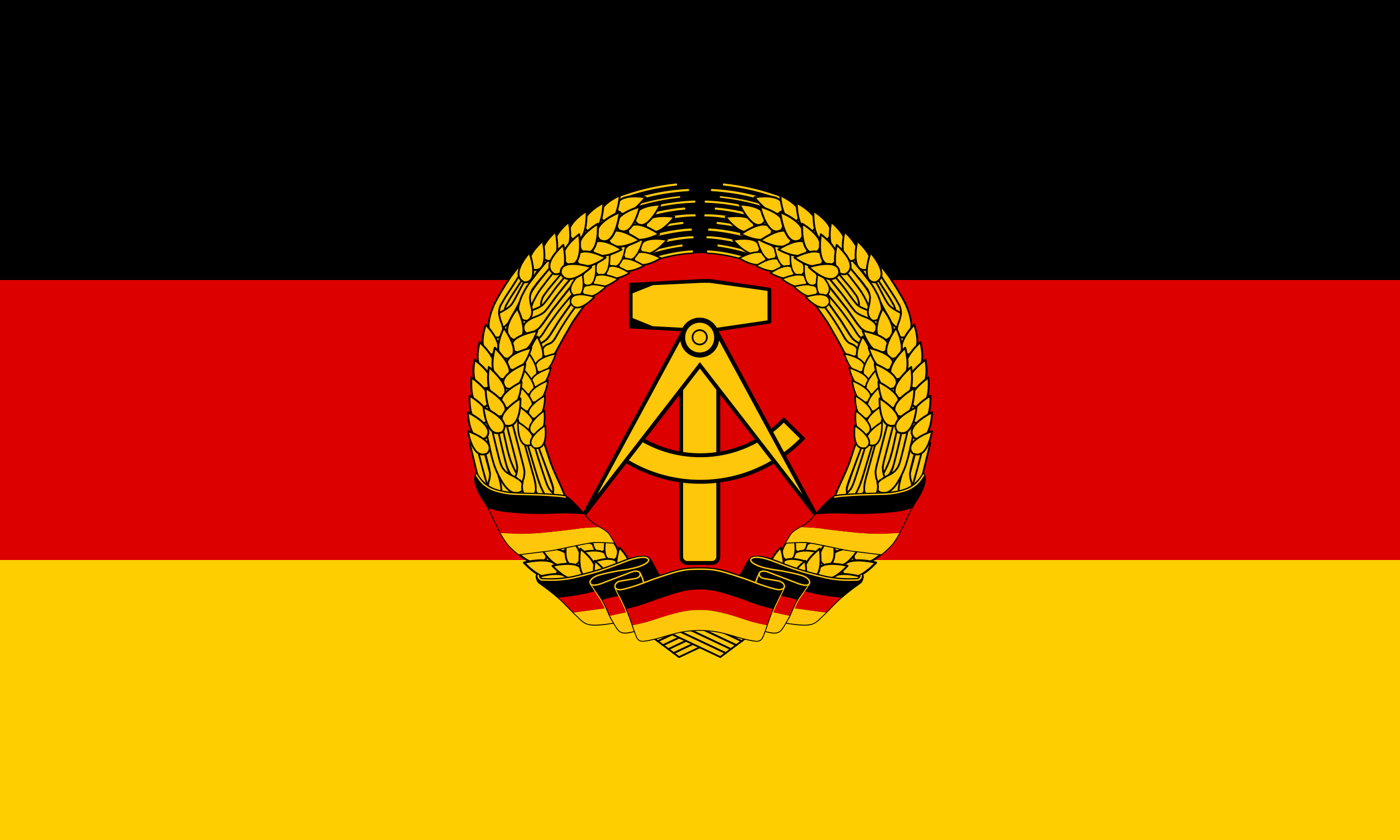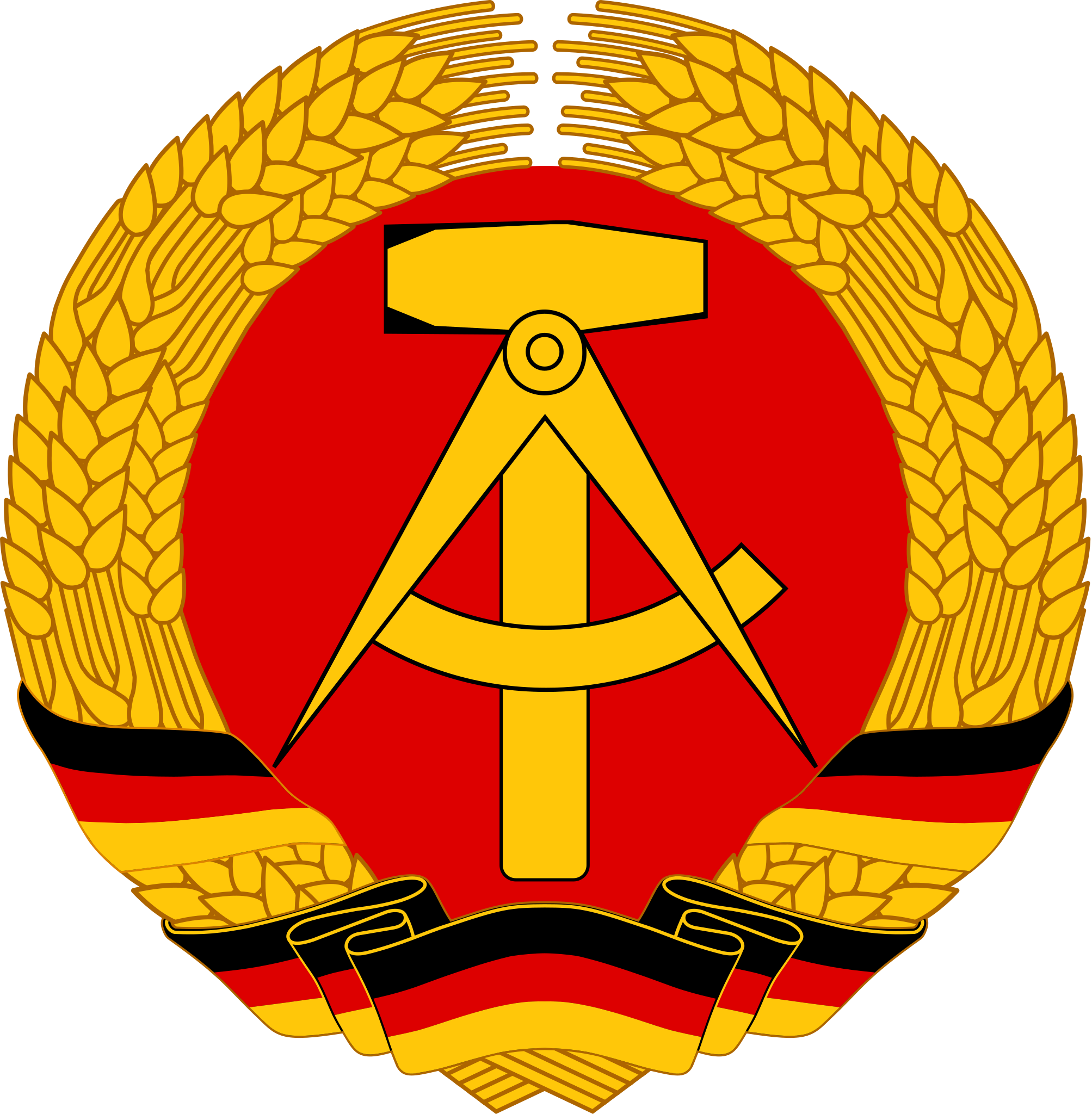German Democratic Republic (1949–1990): Difference between revisions
More languages
More actions
(Reparations) Tag: Visual edit |
No edit summary Tag: Visual edit |
||
| (8 intermediate revisions by 3 users not shown) | |||
| Line 5: | Line 5: | ||
| date_event1 = 9 November 1989 | | date_event1 = 9 November 1989 | ||
| event1 = Fall of [[Anti-Fascist Protection Rampart|Anti-Fascist Protection Wall]] | | event1 = Fall of [[Anti-Fascist Protection Rampart|Anti-Fascist Protection Wall]] | ||
| date_pre = | | date_pre = 2 May 1945 | ||
| event_pre = Soviet liberation of | | event_pre = Soviet liberation of Berlin | ||
| event_start = Constitution adopted | | event_start = Constitution adopted | ||
| event_end = Annexation by West Germany | | event_end = Annexation by West Germany | ||
| Line 45: | Line 45: | ||
| image_flag = GDR flag.png | | image_flag = GDR flag.png | ||
}} | }} | ||
The '''German Democratic Republic''' (German: ''Deutsche Demokratische Republik'' | The '''German Democratic Republic''' ([[German language|German]]: ''Deutsche Demokratische Republik''; often abbreviated '''GDR''' or '''DDR'''), also commonly referred to as '''East Germany''' (German: ''Ostdeutschland''), was a country in [[Central Europe]] that existed from 1949 to 1990. Western media referred to it as a [[communist state]], although it described itself as a [[Socialist state|socialist]] "[[Proletariat|workers]]' and [[Peasantry|peasants]]' state."<ref>'''Chapter 1, Article 1''' of the ''1968 Constitution of the German Democratic Republic (1974 amendments) [[http://www.documentarchiv.de/ddr/verfddr.html Text (in German)]; [https://web.archive.org/web/20220318151408/http://www.documentarchiv.de/ddr/verfddr.html Archived]]''</ref> | ||
The | The DDR was formed on 7 October 1949 with the adoption of its first constitution; elections for the Constitutional Assembly were held 5 months earlier, on 15 and 16 May 1949. | ||
East Germany had free health care and housing, and public transportation was very cheap. Despite spending less money per capita on police, the GDR's crime rate was less than a tenth of that of [[Federal Republic of Germany|West Germany]]'s.<ref name=":0">{{Citation|author=Austin Murphy|year=2000|title=The Triumph of Evil|chapter=A Post-Mortem Comparison of Communist and Capitalist Societies Using the German Case as an Illustration|page=94–102|pdf=https://mltheory.files.wordpress.com/2017/06/austin-murphy-the-triumph-of-evil.pdf|city=Fucecchio|publisher=European Press Academic Publishing|isbn=8883980026}}</ref> | |||
The GDR was annexed by the | The GDR was annexed by the Federal Republic of Germany, also known as West Germany, on 3 October 1990. | ||
== History == | == History == | ||
=== Soviet | === Soviet occupation === | ||
[[File:Divided Germany.png|thumb|The Soviet zone (red) is in the northeast.|317x317px]] | By the end of the [[Second World War]], eastern Germany was poorer and less developed than the west<ref name=":12">{{Citation|author=Bruni de la Motte, John Green|year=2015|title=Stasi State or Socialist Paradise?|chapter=A Difficult Birth - How the GDR Came About|page=18–20|city=London|publisher=Artery Publications|lg=https://libgen.rs/book/index.php?md5=F1F044D71B58A8E0438E6343D942F662}}</ref> and had been since at least the 1910s.<ref>{{Citation|author=[[Vladimir Lenin]]|year=1916|title=Imperialism, the Highest Stage of Capitalism|chapter=Banks and Their New Role|chapter-url=https://www.marxists.org/archive/lenin/works/1916/imp-hsc/ch02.htm|quote=One specialises in German industry, sometimes even in West German industry alone (the West is the most industrialised part of Germany)|city=[[Moscow]]|publisher=Progress Publishers|mia=https://www.marxists.org/archive/lenin/works/1916/imp-hsc/index.htm}}</ref> The [[German Reich (1933–1945)|German Nazis]] had destroyed many cities and villages in an attempt to slow down the [[Union of Soviet Socialist Republics (1922–1991)|Soviet]] [[Workers' and Peasants' Red Army|Red Army]]'s advance. Eastern Germany also had previously relied on the western part of the country for metals and other raw materials.<ref name=":12" />[[File:Divided Germany.png|thumb|The Soviet zone (red) is in the northeast.|317x317px]] | ||
The | The [[Wehrmacht]] (the armed forces of Nazi Germany) surrendered unconditionally on 8 May 1945, six days after [[Battle of Berlin|the Red Army liberated the capital city of Berlin]]. Germany was divided into four occupation zones by the four principal [[Allies of World War II|Allied Powers]] (the [[United States of America|United States]], the [[United Kingdom of Great Britain and Northern Ireland|United Kingdom]], [[French Republic|France]], and the Soviet Union), with the [[Union of Soviet Socialist Republics (1922–1991)|Soviet]] zone (which would later become East Germany) in the northeast. | ||
Authorities in the Soviet zone confiscated property owned by Nazis, convicted Nazis and German soldiers for [[crimes against humanity]], and prevented many of them from holding important positions in government. About 10,000 businesses were expropriated from [[Bourgeoisie|capitalists]] and placed under public ownership. And a land reform programme was introduced in 1945 to remove land from the [[Feudalism|feudal]] [[nobility]].<ref name=":2" /> | |||
At the [[Yalta Conference]] in early 1945, the Allies had agreed to make all of Germany pay reparations to the USSR for the damage it caused during the Second World War. The United States violated this agreement in May 1946 by shielding Western Germany from paying its fair share of the war debt, leading the USSR to blockade West Berlin. When the blockade failed, the Soviet Union decided to make the east pay for all of Germany. Between 1946 and 1953, the Soviets took 25% of East Germany's national income,<ref name=":052" /><sup>:154</sup> including 30% of its 1944 industrial capacity and 48% of its railways. The USSR confiscated Nazi-owned industries, which had made up 60% of total production.<ref name=":12" /> While reasonable given the damage that Germany had inflicted on the Soviet Union in the years prior and the state of the Soviet Union after the war, this only worsened East Germany's already precarious economic situation. | |||
The German People's Council was founded in 1947 and established the German Democratic Republic on 7 October 1949 | As early as June 1945, newly formed [[Anti-fascism|anti-fascist]] and [[Democracy|democratic]] parties were already organizing in the Soviet occupation zone.<ref name=":2" /> The remnants of the [[Communist Party of Germany]] (KPD) and the [[Social Democratic Party of Germany]] (SPD) in the eastern half of the country united to form the [[Socialist Unity Party of Germany]] in 1946, which won the [[1946 Soviet occupation zone state elections|1946 state elections]] with just under 50% of the vote. In [[Free State of Saxony|Saxony]], 72% of the population voted to [[Nationalization|nationalise]] industry. Large estates were redistributed to small farmers.<ref name=":052">{{Citation|author=Austin Murphy|year=2000|title=The Triumph of Evil|chapter=A Comparative Analysis of East and West German Financial Systems in Light of the New Evidence|page=|pdf=https://mltheory.files.wordpress.com/2017/06/austin-murphy-the-triumph-of-evil.pdf|city=Fucecchio|publisher=European Press Academic Publishing|isbn=8883980026}}</ref><sup>:155</sup> | ||
The German People's Council was founded in 1947 and it established the German Democratic Republic on 7 October 1949,<ref name=":2">{{Web citation|newspaper=[[Tricontinental]]|title=Risen from the Ruins: The Economic History of Socialism in the German Democratic Republic|date=2021-04-20|url=https://thetricontinental.org/studies-1-ddr/|archive-url=https://web.archive.org/web/20220426161306/https://thetricontinental.org/studies-1-ddr/|archive-date=2022-04-26|retrieved=2022-08-12}}</ref> about five months after the American, British, and French occupation zones were merged to create the Federal Republic of Germany. | |||
=== Nationalization and collectivization === | === Nationalization and collectivization === | ||
The GDR collectivized agriculture between 1958 and 1960. In 1972, when [[Erich Honecker]] was elected, he nationalized remaining industries, increasing | The GDR collectivized agriculture between 1958 and 1960. In 1972, when [[Erich Honecker]] was elected, he nationalized remaining industries, increasing state ownership from 82% to 99%.<ref name=":052" /> | ||
=== Counterrevolution === | === Counterrevolution === | ||
==== Illegal emigration ==== | ==== Illegal emigration ==== | ||
East Germans, | East Germans, had long traveled to [[Hungarian People's Republic (1949–1989)|Hungary]], but some began using it as a way to get into [[Republic of Austria|Austria]] in the summer of 1989. On 10 August 1989, an aristocrat descended from the [[Austro-Hungarian Monarchy (1867–1918)|Austrian]] emperor incited hundreds of Germans to cross into Austria from Hungary. After Hungary broke its agreement to repatriate East Germans, the GDR ended unrestricted travel into Hungary. It limited travel to Czechoslovakia soon later after a total of 20,000 people had emigrated from East Germany. On 5 October 1989, teenagers tried to break into the Dresden train station at night and threw rocks into windows.<ref name=":05" /><sup>:134–7</sup> | ||
==== Berlin protests ==== | ==== Berlin protests ==== | ||
| Line 104: | Line 106: | ||
== Economy == | == Economy == | ||
From 1951 to 1989, the GDR's GDP grew at an average rate of 4.5% per year, while West Germany's GDP only grew by 4.3%.<ref>{{Citation|author=Karl Mai|year=2009|title=GDR - FRG in an economic-statistical comparison 1950 to 1989 - On new results by Prof. Gerhard Heske|pdf=https://web.archive.org/web/20200613132353/http://www.memo.uni-bremen.de/docs/m3309.pdf|trans-title=DDR – BRD im ökonomisch-statistischen Vergleich 1950 bis 1989 - Zu neuen Ergebnissen von Prof. Gerhard Heske|trans-lang=German}}</ref> | From 1951 to 1989, the GDR's GDP grew at an average rate of 4.5% per year, while West Germany's GDP only grew by 4.3%.<ref>{{Citation|author=Karl Mai|year=2009|title=GDR - FRG in an economic-statistical comparison 1950 to 1989 - On new results by Prof. Gerhard Heske|pdf=https://web.archive.org/web/20200613132353/http://www.memo.uni-bremen.de/docs/m3309.pdf|trans-title=DDR – BRD im ökonomisch-statistischen Vergleich 1950 bis 1989 - Zu neuen Ergebnissen von Prof. Gerhard Heske|trans-lang=German}}</ref> The GDR had more economic growth every year from 1980 to 1987 before dropping behind in 1988.<ref name=":052" /><sup>:173</sup> | ||
{| class="wikitable" | {| class="wikitable" | ||
|+Average Wages of Workers | |+Average Wages of Workers | ||
| Line 122: | Line 124: | ||
|1,130 | |1,130 | ||
|} | |} | ||
Small private companies up to ten employees could exist in the GDR. By the 1980s, all larger companies were state-owned and combined into huge enterprises called ''Kombinate''. The state could buy companies of more than 10 workers at a price determined by their profits.<ref name=":052" /><sup>:155</sup> | |||
The GDR had no unemployment. Although people were protected from being fired for not going to work or not working productively, only 0.1% of work time was lost due to unexcused absences.<ref name=":0" /> | The GDR had no unemployment. Although people were protected from being fired for not going to work or not working productively, only 0.1% of work time was lost due to unexcused absences.<ref name=":0" /> | ||
=== Investment === | |||
Individual companies controlled smaller investments of up to 5 million marks. The [[State Planning Commission (GDR)|State Planning Commission]] controlled larger investments.<ref name=":052" /><sup>:156</sup> | |||
=== Taxes === | |||
Income taxes were around 15% but reached 25% for the highest earners. Instead of using tax forms, the state automatically deducted taxes from workers' wages.<ref name=":0" /> | |||
Taxation rates for businesses were highly progressive and the most profitable businesses paid 90% of their profit in taxes.<ref name=":0" /> Individuals paid up to 10% of their wages to public insurance that covered healthcare and pensions with a maximum rate of 60 Marks per month for workers.<ref name=":4" /> | |||
=== Currency exchange rates === | === Currency exchange rates === | ||
| Line 162: | Line 172: | ||
== Tourism == | == Tourism == | ||
Czechoslovakia was the most popular tourist destination for East Germans because it did not require a special visa, and nine million East Germans visited it in 1988. 800,000 East Germans visited Hungary every year, with hundreds of thousands more passing through Hungary on their way to other countries.<ref name=":05" /><sup>:134–6</sup> | Czechoslovakia was the most popular tourist destination for East Germans because it did not require a special visa, and nine million East Germans visited it in 1988. 800,000 East Germans visited Hungary every year, with hundreds of thousands more passing through Hungary on their way to other countries.<ref name=":05" /><sup>:134–6</sup> | ||
== Further reading == | |||
* ''[[Library:Stasi State or Socialist Paradise?|Stasi State or Socialist Paradise?]]'' | |||
* ''[[Library:The Triumph of Evil|The Triumph of Evil]]'' | |||
==References== | ==References== | ||
Latest revision as of 19:29, 25 March 2024
| German Democratic Republic Deutsche Demokratische Republik | |
|---|---|
| 1949–1990 | |
Motto: Proletarier aller Länder, vereinigt Euch! Workers of the world, unite! | |
Anthem: "Auferstanden aus Ruinen" "Risen from Ruins" | |
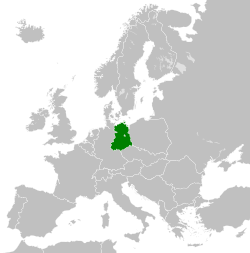 | |
| Capital | East Berlin |
| Official languages | German |
| Dominant mode of production | Socialism |
| Government | Federal Marxist-Leninist socialist republic (1949–1952) Unitary Marxist-Leninist socialist republic (1952–1989) Unitary bourgeois republic (1989–1990) |
• 1946–1950 | Wilhelm Pieck and Otto Grotewohl |
• 1950–1971 | Walter Ulbricht |
• 1971–1989 | Erich Honecker |
• 1989 | Egon Krenz |
| Legislature | Volkskammer |
| History | |
• Soviet liberation of Berlin | 2 May 1945 |
• Constitution adopted | 7 October 1949 |
• Fall of Anti-Fascist Protection Wall | 9 November 1989 |
• Annexation by West Germany | 3 October 1990 |
| Area | |
• Total | 108,333 km² |
| Population | |
• 1990 census | 16,111,000 |
• Density | 149 km² |
| GDP (PPP) | 1989 estimate |
• Total | $525.29 billion |
• Per capita | $42,004 |
| HDI | 0.953 (1989) |
| Currency | East German mark |
| Driving side | right |
| Calling code | +37 |
| Internet TLD | .dd |
| Today part of | Germany |
The German Democratic Republic (German: Deutsche Demokratische Republik; often abbreviated GDR or DDR), also commonly referred to as East Germany (German: Ostdeutschland), was a country in Central Europe that existed from 1949 to 1990. Western media referred to it as a communist state, although it described itself as a socialist "workers' and peasants' state."[1]
The DDR was formed on 7 October 1949 with the adoption of its first constitution; elections for the Constitutional Assembly were held 5 months earlier, on 15 and 16 May 1949.
East Germany had free health care and housing, and public transportation was very cheap. Despite spending less money per capita on police, the GDR's crime rate was less than a tenth of that of West Germany's.[2]
The GDR was annexed by the Federal Republic of Germany, also known as West Germany, on 3 October 1990.
History[edit | edit source]
Soviet occupation[edit | edit source]
By the end of the Second World War, eastern Germany was poorer and less developed than the west[3] and had been since at least the 1910s.[4] The German Nazis had destroyed many cities and villages in an attempt to slow down the Soviet Red Army's advance. Eastern Germany also had previously relied on the western part of the country for metals and other raw materials.[3]
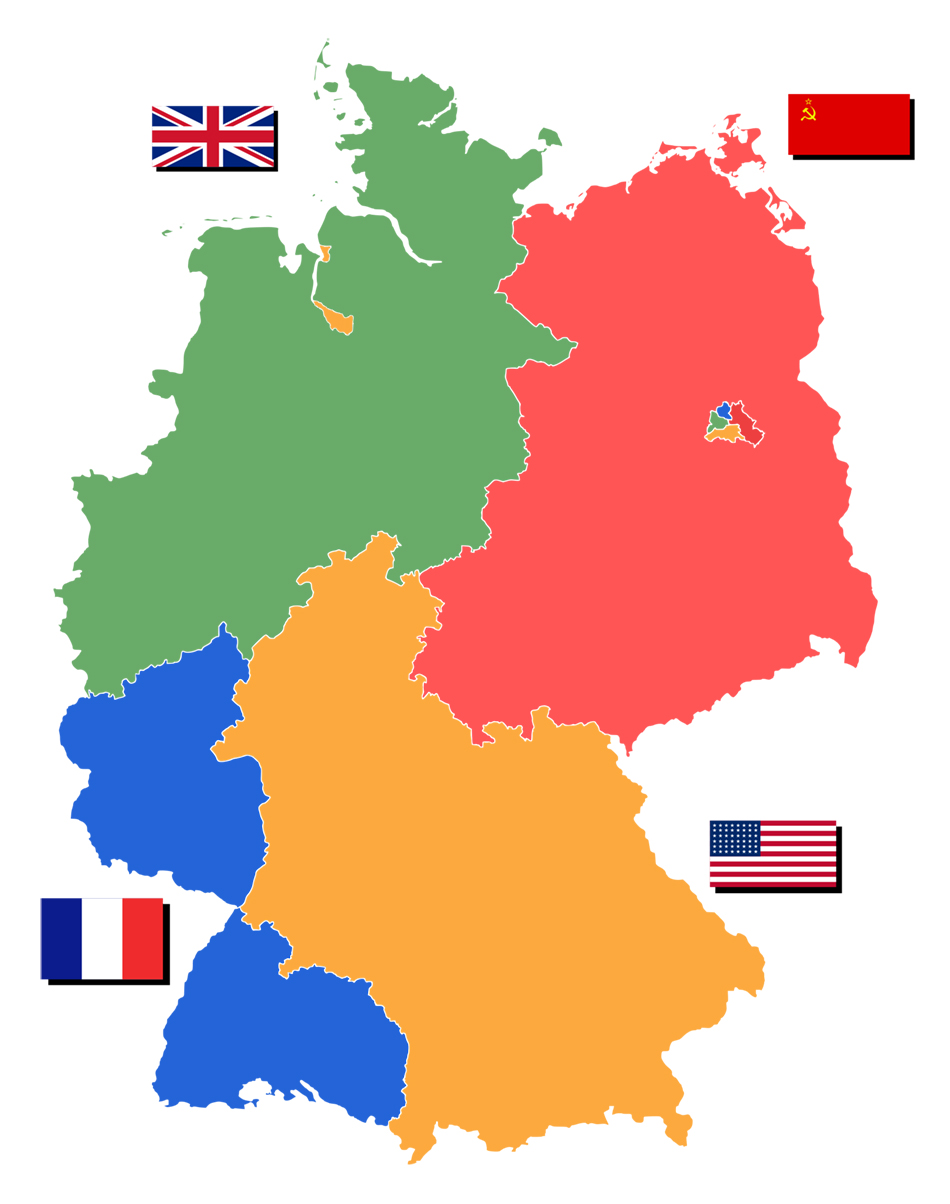
The Wehrmacht (the armed forces of Nazi Germany) surrendered unconditionally on 8 May 1945, six days after the Red Army liberated the capital city of Berlin. Germany was divided into four occupation zones by the four principal Allied Powers (the United States, the United Kingdom, France, and the Soviet Union), with the Soviet zone (which would later become East Germany) in the northeast.
Authorities in the Soviet zone confiscated property owned by Nazis, convicted Nazis and German soldiers for crimes against humanity, and prevented many of them from holding important positions in government. About 10,000 businesses were expropriated from capitalists and placed under public ownership. And a land reform programme was introduced in 1945 to remove land from the feudal nobility.[5]
At the Yalta Conference in early 1945, the Allies had agreed to make all of Germany pay reparations to the USSR for the damage it caused during the Second World War. The United States violated this agreement in May 1946 by shielding Western Germany from paying its fair share of the war debt, leading the USSR to blockade West Berlin. When the blockade failed, the Soviet Union decided to make the east pay for all of Germany. Between 1946 and 1953, the Soviets took 25% of East Germany's national income,[6]:154 including 30% of its 1944 industrial capacity and 48% of its railways. The USSR confiscated Nazi-owned industries, which had made up 60% of total production.[3] While reasonable given the damage that Germany had inflicted on the Soviet Union in the years prior and the state of the Soviet Union after the war, this only worsened East Germany's already precarious economic situation.
As early as June 1945, newly formed anti-fascist and democratic parties were already organizing in the Soviet occupation zone.[5] The remnants of the Communist Party of Germany (KPD) and the Social Democratic Party of Germany (SPD) in the eastern half of the country united to form the Socialist Unity Party of Germany in 1946, which won the 1946 state elections with just under 50% of the vote. In Saxony, 72% of the population voted to nationalise industry. Large estates were redistributed to small farmers.[6]:155
The German People's Council was founded in 1947 and it established the German Democratic Republic on 7 October 1949,[5] about five months after the American, British, and French occupation zones were merged to create the Federal Republic of Germany.
Nationalization and collectivization[edit | edit source]
The GDR collectivized agriculture between 1958 and 1960. In 1972, when Erich Honecker was elected, he nationalized remaining industries, increasing state ownership from 82% to 99%.[6]
Counterrevolution[edit | edit source]
Illegal emigration[edit | edit source]
East Germans, had long traveled to Hungary, but some began using it as a way to get into Austria in the summer of 1989. On 10 August 1989, an aristocrat descended from the Austrian emperor incited hundreds of Germans to cross into Austria from Hungary. After Hungary broke its agreement to repatriate East Germans, the GDR ended unrestricted travel into Hungary. It limited travel to Czechoslovakia soon later after a total of 20,000 people had emigrated from East Germany. On 5 October 1989, teenagers tried to break into the Dresden train station at night and threw rocks into windows.[7]:134–7
Berlin protests[edit | edit source]
On the evening of 7 October 1989, a pro-Gorbachev mob of 10,000 people marched to the Palace of the Republic in Berlin. The police arrested some of them, and fighting eventually broke out. No one died, but several were injured, including police. The Stasi also caught foreign agents from West Germany, Poland, and other countries in Potsdam.[7]:137–40
Leipzig protests[edit | edit source]
On 9 October 1989, people began protesting at a church in Leipzig. Most of them were not religious and used the church as a cover for counterrevolutionary activities. Because Honecker was in meetings all day, he was not able to tell the police what to do. Egon Krenz told the police that they had to avoid using force and prevented them from arresting protestors. Krenz replaced Honecker as leader of the GDR on 18 October.[7]:141–5
Fall of Anti-Fascist Protection Wall[edit | edit source]
On the night of 9 November, border guards opened the border with West Berlin. By 4 a.m. on 10 November, 70,000 people had entered the West, most of which had already returned to the East. The Western ruler Helmut Kohl said he would only send aid to the East if it had bourgeois reforms and Western-style elections. The parliament removed the party's leading role from the constitution and ousted Krenz to replace him with Hans Modrow.[7]:148–9
Western annexation[edit | edit source]
In December 1989, the West pressured Modrow into adopting a 3:1 exchange rate between the Eastern and Western currencies even though the eastern mark had a much higher purchasing power for basic consumer goods. Westerners flowed into the GDR and plundered the country by buying commodities for less than 10% of their normal prices using the new exchange rate.
The majority of East Germans only began to support unification in 1990, when Westerners had dropped the GDR's standard of living by more than two-thirds by shopping there with the 3:1 exchange rate. At this time, they still wanted a left-wing government. Western conservatives promised to establish a 1:1 exchange rate if bourgeois parties won the GDR's elections, leading those parties to narrowly win the 1990 elections and impose a capitalist counterrevolution.[7]:149–50
Government[edit | edit source]
People's Chamber[edit | edit source]
The Volkskammer (People's Chamber) was the highest legislative body in the GDR. It had 500 members who served four-year terms. It elected a Council of State, Council of Ministers, National Defence Council, Supreme Court, and Attorney General.
The Volkskammer could confirm treaties, organize referendums, and make laws.[8]
State Council[edit | edit source]
The State Council consisted of a Chairman, Vice-Chairmen, and other members. It could convene the Volkskammer by a one-third vote, pardon people convicted of crimes, and make decrees while the Volkskammer was not in session. Its Chairman could appoint diplomatic representatives.[8]
Council of Ministers[edit | edit source]
The Council of Ministers was the cabinet of the GDR and consisted of a Chairman, Vice-Chairmen, and the leaders of various ministries.[8]
Electoral system[edit | edit source]
Unlike West Germany, the GDR allowed voters to cast secret ballots against all candidates, and thousands did so at each election.[7]:123
Economy[edit | edit source]
From 1951 to 1989, the GDR's GDP grew at an average rate of 4.5% per year, while West Germany's GDP only grew by 4.3%.[9] The GDR had more economic growth every year from 1980 to 1987 before dropping behind in 1988.[6]:173
| Year | Monthly wage (DDM)[10] |
|---|---|
| 1950 | 311 |
| 1960 | 555 |
| 1970 | 755 |
| 1985 | 1,130 |
Small private companies up to ten employees could exist in the GDR. By the 1980s, all larger companies were state-owned and combined into huge enterprises called Kombinate. The state could buy companies of more than 10 workers at a price determined by their profits.[6]:155
The GDR had no unemployment. Although people were protected from being fired for not going to work or not working productively, only 0.1% of work time was lost due to unexcused absences.[2]
Investment[edit | edit source]
Individual companies controlled smaller investments of up to 5 million marks. The State Planning Commission controlled larger investments.[6]:156
Taxes[edit | edit source]
Income taxes were around 15% but reached 25% for the highest earners. Instead of using tax forms, the state automatically deducted taxes from workers' wages.[2]
Taxation rates for businesses were highly progressive and the most profitable businesses paid 90% of their profit in taxes.[2] Individuals paid up to 10% of their wages to public insurance that covered healthcare and pensions with a maximum rate of 60 Marks per month for workers.[11]
Currency exchange rates[edit | edit source]
The purchasing power of the East and West German Marks were similar, but the eastern mark could buy five to ten times as much food or clothing in the GDR than the western mark could in West Germany. In December 1989, in response to Western pressure, the GDR adopted an exchange rate of 3 eastern marks to 1 western mark. At that time, 70% of the GDR's population supported socialism and independence.[7]:149–50
Education[edit | edit source]
After the Second World War, teachers who had connections to the Nazi Party were fired and 40,000 new teachers were trained in a short time.[5]
Daycare and preschool[edit | edit source]
Very cheap daycare was available in the GDR and was open for up to 12 hours per day. 80% of children under three years old attended day care.[2] In 1985, there were 13,148 preschools in the DDR attended by children from ages three to six. Attendance was not mandatory but 91% of eligible children participated.[12]
Primary and secondary education[edit | edit source]
Starting at the age of six, there were ten years of mandatory education. In grades seven through ten, 22% of instruction time was spent on science, 15% on math, and 34% on history, language, and literature. English and Russian were also taught as foreign languages.[12]
Higher education[edit | edit source]
After completing the compulsory ten years of education, students could go to a university or vocational school. There were 54 universities and colleges and 963 vocational schools in the country. College was cheap and had no tuition fee,[2] and many textbooks were available for free.[12] There was no student debt and students did not need jobs while in college.[13]
Health care[edit | edit source]
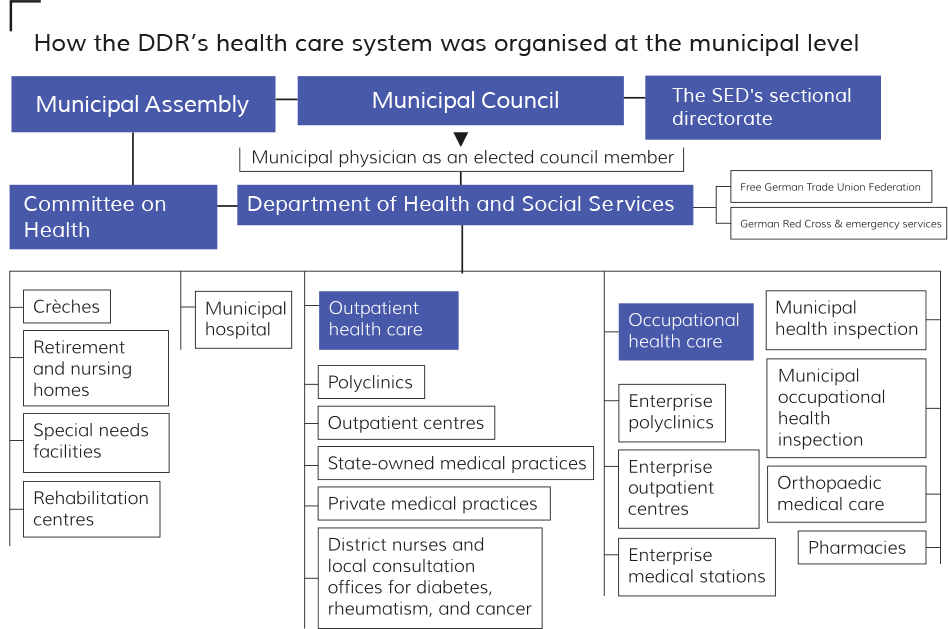
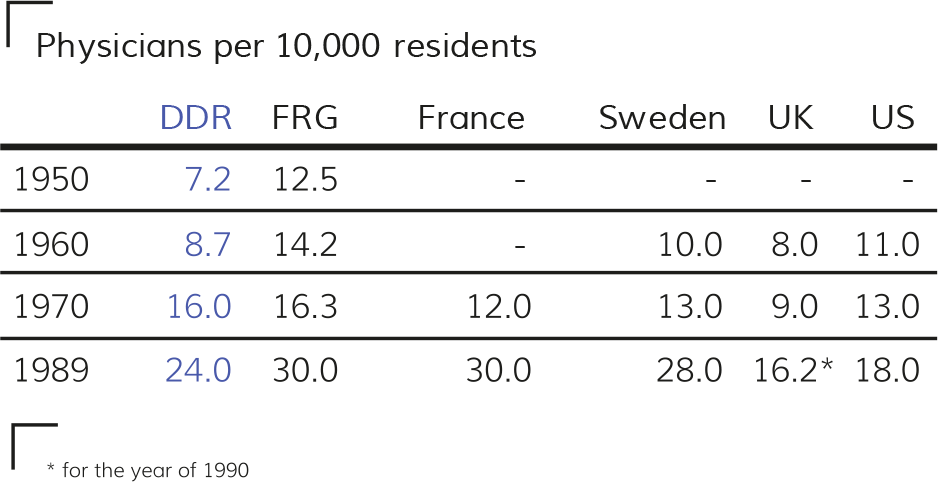
During the late 1940s, disease was widespread because the Second World War had destroyed many hospitals and universities, preventing new doctors from being trained. 45% of surviving doctors were former Nazis, and many of them fled to West Germany. Soviet authorities established the Central Health Administration in 1945 and introduced a public health insurance in 1947. The number of doctors tripled to reach 41,000 by 1988 even though thousands illegally crossed the border to West Germany.
The GDR had a highly developed health care system that employed almost 600,000 people or 7% of the total workforce. By 1970, it surpassed the UK and USA in terms of physicians per capita and had 24 doctors per 10,000 people in 1989. The Kombinat GERMED operated 13 enterprises and three research institutes and produced 80–90% of the country's pharmaceuticals while also exporting to other countries.
Churches retained control of many hospitals after the foundation of the GDR but were integrated into the state planning system. Doctors were required to work in areas with few doctors (usually rural) for the first several years after receiving their license.
The GDR created a system of publicly owned polyclinics to treat a wide variety of diseases. In addition, smaller outpatient centers existed.[11]
Housing[edit | edit source]
Evictions were illegal in the GDR, and rent averaged less than 10% of total income.[13]
Women's rights[edit | edit source]
80% of women in the GDR between the ages of 18 and 60 were employed. By 1985, half of the university students in the country were women, doubling from a quarter in 1960.[14] By the mid-1980s, birth control pills were also available free of charge.[15]
Six months of paid maternity leave were given for the birth of the first child, a year for the second child, and 18 months for subsequent children.[2]
Tourism[edit | edit source]
Czechoslovakia was the most popular tourist destination for East Germans because it did not require a special visa, and nine million East Germans visited it in 1988. 800,000 East Germans visited Hungary every year, with hundreds of thousands more passing through Hungary on their way to other countries.[7]:134–6
Further reading[edit | edit source]
References[edit | edit source]
- ↑ Chapter 1, Article 1 of the 1968 Constitution of the German Democratic Republic (1974 amendments) [Text (in German); Archived]
- ↑ 2.0 2.1 2.2 2.3 2.4 2.5 2.6 Austin Murphy (2000). The Triumph of Evil: 'A Post-Mortem Comparison of Communist and Capitalist Societies Using the German Case as an Illustration' (pp. 94–102). [PDF] Fucecchio: European Press Academic Publishing. ISBN 8883980026
- ↑ 3.0 3.1 3.2 Bruni de la Motte, John Green (2015). Stasi State or Socialist Paradise?: 'A Difficult Birth - How the GDR Came About' (pp. 18–20). London: Artery Publications. [LG]
- ↑ “One specialises in German industry, sometimes even in West German industry alone (the West is the most industrialised part of Germany)”
Vladimir Lenin (1916). Imperialism, the Highest Stage of Capitalism: 'Banks and Their New Role'. Moscow: Progress Publishers. [MIA] - ↑ 5.0 5.1 5.2 5.3 "Risen from the Ruins: The Economic History of Socialism in the German Democratic Republic" (2021-04-20). Tricontinental. Archived from the original on 2022-04-26. Retrieved 2022-08-12.
- ↑ 6.0 6.1 6.2 6.3 6.4 6.5 Austin Murphy (2000). The Triumph of Evil: 'A Comparative Analysis of East and West German Financial Systems in Light of the New Evidence'. [PDF] Fucecchio: European Press Academic Publishing. ISBN 8883980026
- ↑ 7.0 7.1 7.2 7.3 7.4 7.5 7.6 7.7 Austin Murphy (2000). The Triumph of Evil: 'A Detailed Autopsy of the Collapse of the Superior System in the Divided Germany'. [PDF] Fucecchio: European Press Academic Publishing. ISBN 8883980026
- ↑ 8.0 8.1 8.2 German Democratic Republic (1968). Constitution of the German Democratic Republic: 'Structure and System of State Management'.
- ↑ Karl Mai (2009). GDR - FRG in an economic-statistical comparison 1950 to 1989 - On new results by Prof. Gerhard Heske (German: DDR – BRD im ökonomisch-statistischen Vergleich 1950 bis 1989 - Zu neuen Ergebnissen von Prof. Gerhard Heske). [PDF]
- ↑ Stephen R. Burrant (1987). East Germany: A Country Study: 'The Economy; The Consumer in the East German Economy' (p. 154). United States Federal Research Division.
- ↑ 11.0 11.1 "‘Socialism Is the Best Prophylaxis’: The German Democratic Republic’s Health Care System" (2023-02-14). Tricontinental. Archived from the original on 2023-02-14. Retrieved 2023-02-26.
- ↑ 12.0 12.1 12.2 Stephen R. Burrant (1987). East Germany: A Country Study: 'The Society and Its Environment; The Educational System'. United States Federal Research Division.
- ↑ 13.0 13.1 Victor Grossman (2022-08-24). "My seventy years and the departed GDR" Monthly Review. Archived from the original on 2022-08-25. Retrieved 2022-08-26.
- ↑ Stephen R. Burrant (1987). East Germany: A Country Study: 'The Society and Its Environment; Women and the Democratic Women's League of Germany' (p. 102). United States Federal Research Division.
- ↑ Stephen R. Burrant (1987). East Germany: A Country Study: 'The Society and Its Environment; Institutions and Organs of Society' (p. 95). United States Federal Research Division.

